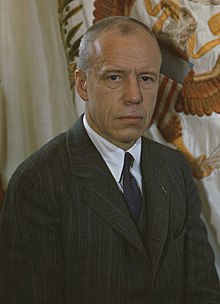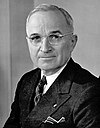Robert P. Patterson
Robert P. Patterson | |
|---|---|
 | |
| 55th United States Secretary of War | |
| In office September 27, 1945 – July 18, 1947 | |
| President | Harry S. Truman |
| Preceded by | Henry L. Stimson |
| Succeeded by | Kenneth Claiborne Royall |
| United States Under Secretary of War | |
| In office December 16, 1940 – September 27, 1945 | |
| President | Franklin D. Roosevelt Harry S. Truman |
| Preceded by | Office established |
| Succeeded by | Kenneth Claiborne Royall |
| Judge of the United States Court of Appeals for the Second Circuit | |
| In office March 21, 1939 – July 30, 1940 | |
| Appointed by | Franklin D. Roosevelt |
| Preceded by | Martin Thomas Manton |
| Succeeded by | Jerome Frank |
| Judge of the United States District Court for the Southern District of New York | |
| In office May 13, 1930 – March 22, 1939 | |
| Appointed by | Herbert Hoover |
| Preceded by | Thomas D. Thacher |
| Succeeded by | Simon H. Rifkind |
| Personal details | |
| Born | Robert Porter Patterson February 12, 1891 Glen Falls, New York, U.S. |
| Died | January 22, 1952 (aged 60) Elizabeth, New Jersey |
| Resting place | Arlington National Cemetery |
| Political party | Republican |
| Children | Robert P. Patterson Jr. |
| Education | Union College (AB) Harvard University (LLB) |
| Military service | |
| Allegiance | |
| Branch/service | |
| Years of service | 1917–1919 |
| Rank | Major |
| Unit | 306th Infantry Regiment |
| Battles/wars | World War I |
| Awards | Distinguished Service Cross Distinguished Service Medal Silver Star |
Robert Porter Patterson Sr. (February 12, 1891 – January 22, 1952) was an American judge who served as
Education and career
Born on February 12, 1891, in Glens Falls, New York,[1] the son of Lodice Edna (née Porter) and Charles Robert Patterson,[citation needed] Patterson received an Artium Baccalaureus degree in 1912 from Union College and a Bachelor of Laws in 1915 from Harvard Law School.[1] He entered private practice in New York City from 1915 to 1916,[1] with what today is the law firm of Patterson Belknap Webb & Tyler,[citation needed] also serving with that firm in subsequent periods of private practice.[citation needed] He served in the New York Army National Guard from 1916 to 1917.[1] He served in the United States Army from 1917 to 1919,[1] attaining the rank of Major.[citation needed] He received the Distinguished Service Cross[2] and Silver Star[2] for heroism in France. Patterson served in the 306th Infantry Regiment which was assigned to the 77th Infantry Division.[citation needed] He returned to private practice in New York City from 1919 to 1930.[1]
Federal judicial service
Patterson was nominated by President Herbert Hoover on April 24, 1930, to a seat on the United States District Court for the Southern District of New York vacated by Judge Thomas D. Thacher.[1] He was confirmed by the United States Senate on May 13, 1930, and received his commission the same day.[1] His service terminated on March 22, 1939, due to his elevation to the Second Circuit.[1]
Patterson was nominated by President Franklin D. Roosevelt on February 9, 1939, to a seat on the United States Court of Appeals for the Second Circuit vacated by Judge Martin Thomas Manton.[1] He was confirmed by the Senate on March 20, 1939, and received his commission on March 21, 1939.[1] His service terminated on July 30, 1940, due to his resignation.[1]
War Department service

Patterson served as a
Patterson worked to promote more black participation and promotion with in the military, specifically during the late stages of
Later career
After declining an offer by President Truman to be reappointed to his former judgeship,[
Personal life
On January 3, 1920, Patterson married Margaret Tarleton Winchester (1897–1988); they had four children: Robert P. Patterson, Jr., Aileen W. Patterson, Susan H. Patterson and Virginia D. Patterson.[citation needed] Robert P. Patterson Jr. was a federal judge in the Southern District of New York, until his death in 2015.[13]
Patterson housed William L. Marbury Jr., at his Georgetown home.[citation needed] After the war, he recommended Marbury to succeed him at the United Nations; upon advice from Alger Hiss, Marbury declined.[citation needed] (Marbury soon thereafter represented Hiss in his slander case against Whittaker Chambers.)[14]
Death
Patterson died on January 22, 1952,[1] returning from meeting a client, onboard American Airlines Flight 6780 which crashed on the approach to Newark Airport in Elizabeth, New Jersey; he was age 60.[citation needed]
Works
In 2012, the University of Tennessee Press published The World War I Memoirs of Robert P. Patterson: A Captain in the Great War, edited by J. Garry Clifford.[citation needed]
In 2014, the University of Tennessee Press published his previously unpublished 1947 memoir Arming the Nation for War, with a foreword by
- The World War I Memoirs of Robert P. Patterson: A Captain in the Great War (2012)
- Arming the Nation for War: Mobilization, Supply, and the American War Effort in World War II (2014)
References
- ^ a b c d e f g h i j k l m n o p q r Robert Porter Patterson Sr. at the Biographical Directory of Federal Judges, a publication of the Federal Judicial Center.
- ^ a b Sterner, Doug. "Valor awards for Robert Porter Patterson". Military Times Hall of Valor. Military Times. Retrieved January 12, 2017.
- ISBN 978-1-4000-6964-4.
- ^ Eiler, op. cit. pp. 443–444
- ISBN 978-0-16-087640-0.
- ^
"Task of Occupation Declared in Peril; Patterson at Dinner Honoring War Correspondents Says More Appropriations Are Needed". Washington DC. 1946-11-23. p. 28. Retrieved 2020-11-26.
- ^ The Crisis Publishing Company, Inc. (November 1945). The Crisis. The Crisis Publishing Company, Inc. pp. 324–.
- ISBN 978-1-5017-2387-2.
- ISBN 978-0-226-30171-6.
- ISBN 978-1-57233-882-1.
- ^ Dewey Names 3 Men to Study 'All Aspects' of the L.I. Road, The New York Times, November 26, 1950
- ^ Dewey Asks State Control of Long Island Road, Geneva Daily Times, March 8, 1951
- ^ Robert Porter Patterson Jr. at the Biographical Directory of Federal Judges, a publication of the Federal Judicial Center.
- ^ Marbury, Jr., William L. (1981). "The Hiss-Chambers Libel Suit". Maryland Historical Magazine. 76 (1): 74 (Georgetown), 76 (UN job). Retrieved 23 November 2016.
Sources
- Eiler, Keith. (1997) Mobilizing America: Robert P. Patterson and the War Effort, 1940–1945. Cornell University Press.
External links
- Robert Porter Patterson Sr. at the Biographical Directory of Federal Judges, a publication of the Federal Judicial Center.



